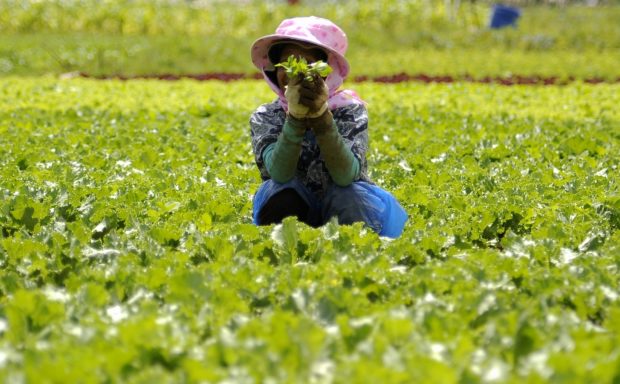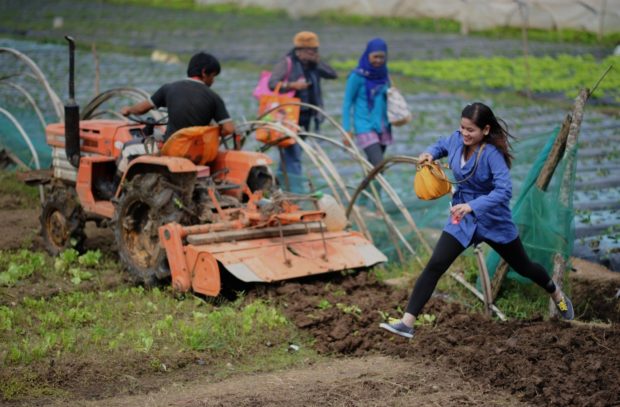‘Living veggies’ reintroduce Benguet crops

MODELS AND CROPS Benguet models Jade Sangao, Marilou Saguidec, Seth Wanye Chacapna and Karen Evasco wear vegetable-accented costumes fashioned by designer Hilson Busoy to draw attention to Benguet’s vegetables. —VANESSA CARANTES
LA TRINIDAD, Benguet, Philippines — Each day, teams of packers haul plastic bags of potatoes newly dug from the mountain gardens of Benguet province to trucks waiting for delivery to Metro Manila.
Around them, women wrap heaps of carrots in neatly cut newspapers. At the loading bay, men trim the leaves off heads of cauliflowers.
This had been the work routine at the Benguet Agri-Pinoy Trading Center (BAPTC) since its inauguration in 2016, until the disruption on Feb. 15, when the workers took time off to steal shots of model Jade Sangao in a vegetable G-string and crown.
Sangao and three other models who were similarly dressed like living vegetables are helping reinvent Benguet’s leading crops and open new markets, according to Violeta Salda, BAPTC chief operating officer.
Since the 1970s, Benguet has monopolized the country’s supply of semitemperate vegetables, building its reputation as the “Salad Bowl of the Philippines.”
Article continues after this advertisementThe province produces an average of 1.1 billion kilograms of vegetables like potato, cabbage, chayote, carrot, lettuce and broccoli, to corner 80 percent of the nationwide demand, records from provincial agriculture office showed.
Article continues after this advertisementVegetable farms are spread across 56,974 hectares in Benguet’s 13 towns, or 20 percent of the province’s total land area of 283,300 ha, based on Benguet’s 2018 data. Farmers comprised one-fourth of the population of 403,944.
Buguias town has the widest farmlands, spanning 9,378 ha, or more than half of its 17,588-ha land area. The farms exceed the 8,097 ha of land classified as agricultural in the municipal comprehensive land use plan.

DOLLED UP Karen Evasco hails from vegetable-producing Atok town and is part of a remarketing campaign for the province’s major crops. —PHOTOS BY VANESSA CARANTES AND EV ESPIRITU
Smuggled crops
But since the early 1990s, Benguet farmers have grappled with the flood of imported and smuggled crops that has gnawed at the market it used to control.
A key to countering the impact of free trade was the establishment of BAPTC at a cost of P727 million, which was touted as the largest agricultural facility in the Philippines in 2016.
To date, the 4-ha trading center has captured 30 percent of the highland vegetable trade, including vegetables grown in the adjacent provinces of Ifugao, Nueva Vizcaya and Mountain Province, Salda said.
As of 2018, BAPTC facilitated the trade of 106 million kilos of vegetables valued at P2 billion, based on the monthly average volume and prices.
Most vegetables are still sold at La Trinidad Vegetable Trading Post because many farmers still maintain ties to traders there who loan out capital.
Envisioned to modernize farmers’ access to local and global markets, BAPTC sought to shorten the business chain from farmers to retailers by eliminating the need for layers of brokers to deliver vegetables to consumers at far lower prices.
It was also designed as a socioeconomic enterprise, a training center for farmers, and a postprocessing and postharvest facility.

FRESHWEAR The Benguet vegetable marketing campaign required models to wear garments put together using vegetables like cabbage, lettuce and cauliflower. The dresses were periodically sprinkled with water to keep them fresh. —EV ESPIRITU

EDIBLE CROWN Bokod town resident Jade Sangao holds a crown made of vegetables for a billboard photoshoot promoting Benguet’s agriculture industry. —EV ESPIRITU
How it started
According to historians, the Benguet vegetable trade evolved from a failed attempt in the 1950s by a group of Chinese farmers to grow tobacco at rented farms at Barangay Loo in Buguias.
The Chinese decided to plant one vegetable after another when they realized that these plants were suitable for the province’s high altitude.
Soon, food production became so massive the Chinese farmers had to share their technology with the Ibaloy and Kankanaey peoples, whom they supported financially to start their own gardens. Profits from harvests were shared between farmers and capitalists after deducting operational costs.
But vegetable farming has been recorded as far back as the 19th century.
“By the turn of the 20th century, Europeans in the Baguio-Benguet area were consuming cabbages, peas, tomatoes and other temperate vegetables. Surplus Irish potatoes from Benguet farms also started making their appearance in Manila,” said Ben Tapang, a retired economics professor at the University of the Philippines Baguio, in a monograph titled “The Ibaloy Cattle Enterprise in Benguet.”
Tapang said the construction of Kennon Road played a role in developing Benguet’s vegetable trade. Foreigners among the crew building the zigzag road settled later in Cordillera and created La Trinidad’s vegetable gardens in 1910.
Guy Haight, an American expatriate, sent down pack horses ferrying cabbages, carrots and lettuce grown in a 24-ha homestead in Atok town, which used to be called Paoay.
In due time, vegetable gardening flourished in nearby mountain towns. Vegetables were transported by trucks or buses to merchants in Baguio or directly to Manila.

LIFEBLOOD Aquarter of Benguet’s population tend to vegetable gardens carved out of mountains. The province’s farms grow carrot, cabbage, lettuce and potato across 56,974 hectares of Benguet’s 13 towns, including the capital La Trinidad, which tourists visit for its strawberries. —EV ESPIRITU

TRADING CENTER The Benguet Agri-Pinoy Trading Center, built in 2016, is considered as the largest agricultural trading facility in the country. —EV ESPIRITU
Expanding trade
In 1989, the La Trinidad Vegetable Trading Post was established, partially funded by the US Agency for International Development. It served as the main trading center for vegetables from Cordillera that were shipped to other parts of the country.
On March 4, Salda met with officials of the Department of Agriculture (DA) to promote trade with 26 trading centers across the country.
She urged the Food Terminal Inc. facility in Taguig City to accommodate vegetables from BAPTC and reduce the volume of produce being transported to Divisoria in Manila. About 70 percent of vegetables from the Cordillera are delivered to Divisoria, where the crops are repacked and shipped to various markets, according to the DA agri-marketing assistance division.
The aggressive promotion of Benguet produce would be aided soon by billboards featuring the “living vegetables.”
Salda said the campaign would herald BAPTC as “a marketing arm for the farmers by the farmers.”
